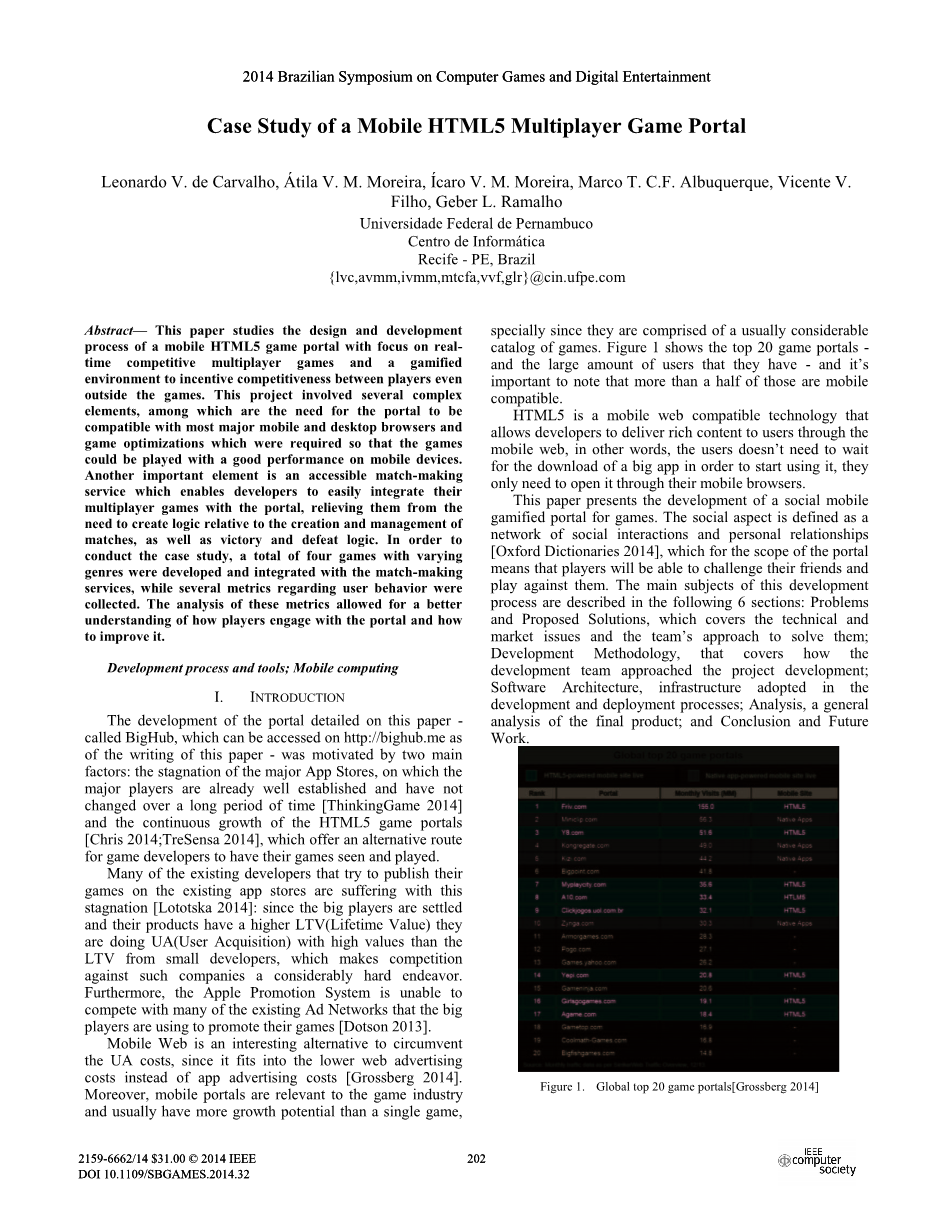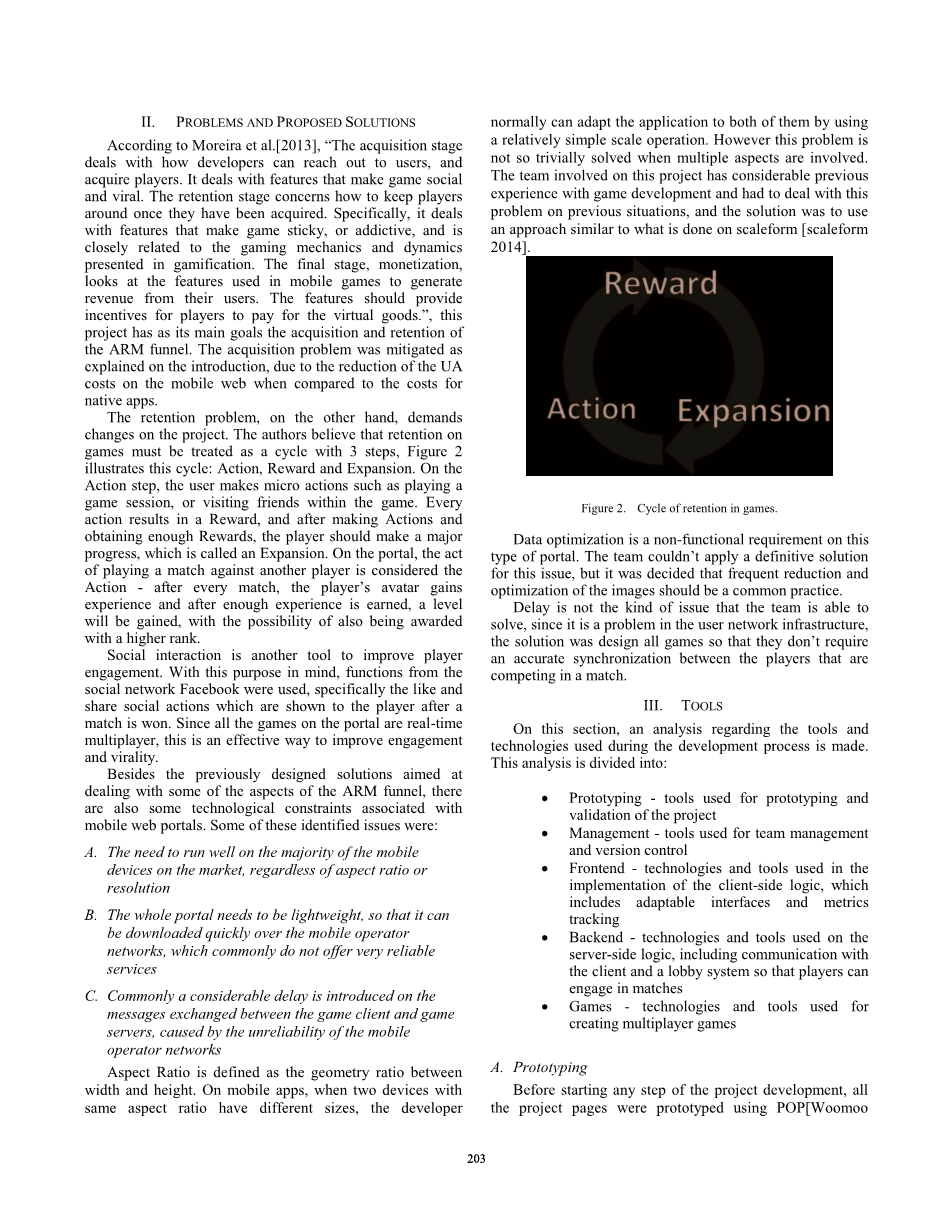

英语原文共 8 页,剩余内容已隐藏,支付完成后下载完整资料
Case Study of a Mobile HTML5 Multiplayer Game Portal
2014 Brazilian Symposium on Computer Games and Digital Entertainment
Leonardo V. de Carvalho, Aacute;tila V. M. Moreira, Iacute;caro V. M. Moreira, Marco T. C.F. Albuquerque, Vicente V. Filho, Geber L. Ramalho
Universidade Federal de Pernambuco Centro de Informaacute;tica
Recife - PE, Brazil
{lvc,avmm,ivmm,mtcfa,vvf,glr}@cin.ufpe.com
Abstract— This paper studies the design and development process of a mobile HTML5 game portal with focus on real- time competitive multiplayer games and a gamified environment to incentive competitiveness between players even outside the games. This project involved several complex elements, among which are the need for the portal to be compatible with most major mobile and desktop browsers and game optimizations which were required so that the games could be played with a good performance on mobile devices. Another important element is an accessible match-making service which enables developers to easily integrate their multiplayer games with the portal, relieving them from the need to create logic relative to the creation and management of matches, as well as victory and defeat logic. In order to conduct the case study, a total of four games with varying genres were developed and integrated with the match-making services, while several metrics regarding user behavior were collected. The analysis of these metrics allowed for a better understanding of how players engage with the portal and how to improve it.
Development process and tools; Mobile computing
- INTRODUCTION
The development of the portal detailed on this paper - called BigHub, which can be accessed on http://bighub.me as of the writing of this paper - was motivated by two main factors: the stagnation of the major App Stores, on which the major players are already well established and have not changed over a long period of time [ThinkingGame 2014] and the continuous growth of the HTML5 game portals [Chris 2014;TreSensa 2014], which offer an alternative route for game developers to have their games seen and played.
Many of the existing developers that try to publish their games on the existing app stores are suffering with this stagnation [Lototska 2014]: since the big players are settled and their products have a higher LTV(Lifetime Value) they are doing UA(User Acquisition) with high values than the LTV from small developers, which makes competition against such companies a considerably hard endeavor. Furthermore, the Apple Promotion System is unable to compete with many of the existing Ad Networks that the big players are using to promote their games [Dotson 2013].
Mobile Web is an interesting alternative to circumvent the UA costs, since it fits into the lower web advertising costs instead of app advertising costs [Grossberg 2014]. Moreover, mobile portals are relevant to the game industry and usually have more growth potential than a single game,
202
2159-6662/14 $31.00 copy; 2014 IEEE DOI 10.1109/SBGAMES.2014.32
2159-6662/14 $31.00 copy; 2014 IEEE DOI 10.1109/SBGAMES.2014.32
specially since they are comprised of a usually considerable catalog of games. Figure 1 shows the top 20 game portals - and the large amount of users that they have - and itrsquo;s important to note that more than a half of those are mobile compatible.
HTML5 is a mobile web compatible technology that allows developers to deliver rich content to users through the mobile web, in other words, the users doesnrsquo;t need to wait for the download of a big app in order to start using it, they only need to open it through their mobile browsers.
This paper presents the development of a social mobile gamified portal for games. The social aspect is defined as a network of social interactions and personal relationships [Oxford Dictionaries 2014], which for the scope of the portal means that players will be able to challenge their friends and play against them. The main subjects of this development process are described in the following 6 sections: Problems and Proposed Solutions, which covers the technical and market issues and the teamrsquo;s approach to solve them; Development Methodology, that covers how the development team approached the project development; Software Architecture, infrastructure adopted in the development and deployment processes; Analysis, a general analysis of the final product; and Conclusion and Future Work.
Figure 1. Global top 20 game portals[Grossberg 2014]
2014 Brazilian Symposium on Computer Games and Digital Entertainment
202
- PROBLEMS AND PROPOSED SOLUTIONS According to Moreira et al.[2013], “The acquisition stage
deals with how developers can reach out to users, and acquire players. It deals with features that make game social and viral. The retention stage concerns how to keep players around once they have been acquired. Specifically, it deals with features that make game sticky, or addictive, and is closely related to the gaming mechanics and dynamics presented in gamification. The final stage, monetization, looks at the features used in mobile games to generate revenue from their users. The features should provide incentives for players to pay for the virtual goods.”, this project has as its main goals the acquisition and retention of the ARM funnel. The acquisition problem was mitigated as explained on the introduction, due to the reduction of the UA costs on the mobile web when compared to the costs for native apps.
The retention problem, on the other hand, demands changes on the project. The authors believe that retention on games must be treated as a cycle with 3 steps, Figure 2 illustrates this cycle: Action, Reward and Expansion. On the Action step, the user makes micro actions such as playing a game sess
全文共45200字,剩余内容已隐藏,支付完成后下载完整资料
资料编号:[12375],资料为PDF文档或Word文档,PDF文档可免费转换为Word
以上是毕业论文外文翻译,课题毕业论文、任务书、文献综述、开题报告、程序设计、图纸设计等资料可联系客服协助查找。


